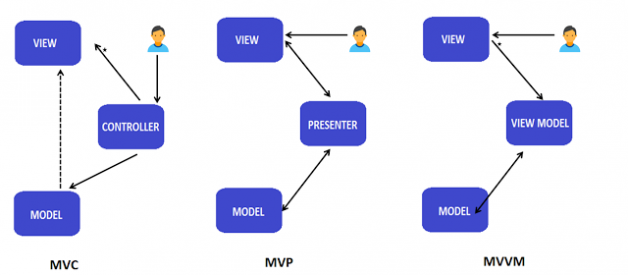MVC, MVP, and MVVM are three popular design patterns in software development. Let?s have a look on Model View Controller (MVC), Model View Presenter (MVP) and Model View View-model (MVVM) one by one. All these design patterns by and large help in developing applications that are loosely combined, easy to test and maintain. All discussion about the pattern is made in context of Android as a platform.

Model View Controller (MVC)
MVC design pattern divides an application into three major aspects: Model, View, and Controller.
Model
Model means data that is required to display in the view. Model represents a collection of classes that describes the business logic (business model and the data model). It also defines the business rules for data means as how the data can be changed and manipulated.
View
The View represents UI components like XML, HTML etc. View displays the data that is received from the controller as the outcome. In MVC pattern View monitors the model for any state change and displays updated model. Model and View interact with each other using the Observer pattern.
Controller
The Controller is responsible to process incoming requests. It processes the user?s data through the Model and passing back the results to View. It normally acts as a mediator between the View and the Model.
Model View Presenter (MVP)
The MVP pattern is similar to the MVC pattern. It is derived from MVC pattern, wherein the controller is replaced by the presenter. This pattern divides an application into three major aspects: Model, View, and Presenter.
Model
The Model represents a set of classes that describes the business logic and data. It also defines business rules for data means how the data can be changed and manipulated.
View
View is a component which is directly interacts with user like XML, Activity, fragments. It does not contain any logic implemented.
Presenter
The Presenter receives the input from users via View, then process the user?s data with the help of Model and passing the results back to the View. Presenter communicates with view through interface. Interface is defined in presenter class, to which it pass the required data. Activity/fragment or any other view component implement this interface and renders the data in a way they want.
In the MVP design pattern, the presenter manipulates the model and also updates the view. In MVP View and Presenter are completely decoupled from each other?s and communicate to each other?s by an interface. Because if decoupling mocking of the view is easier and unit testing of applications that leverage the MVP design pattern over the MVC design pattern are much easier.
Model View View-model (MVVM)
MVVM pattern supports two-way data binding between View and View-Model. This allows automatic propagation of changes, inside the state of View-Model to the View. Generally, the View-Model utilizes the observer pattern to inform changes in the View-Model to the Model.
View-Model
It is responsible for exposing methods, commands, and other properties that help to maintain the state of the view, manipulate the model as the result of actions on the view, and trigger events in the view itself. View has a reference to View-Model but View-Model has no information about the View. There is many-to-one relationship between View and View-Model means many Views can be mapped to one View-Model. It is completely independent of Views.
The bi-directional data binding or the two way data binding between the view and the View-Model ensures that the models and properties in the View-Model is in sync with the view. The MVVM design pattern is well suited in applications that need support for bi-directional data binding.
For more deep explanation refer: http://geekswithblogs.net/dlussier/archive/2009/11/21/136454.aspx
Thanks for reading. To help others please click ? to recommend this article if you found it helpful.
Check out my blogger page for more interesting topics on Software development at http://androidjavapoint.blogspot.in
You can also find my Android Applications on play store


